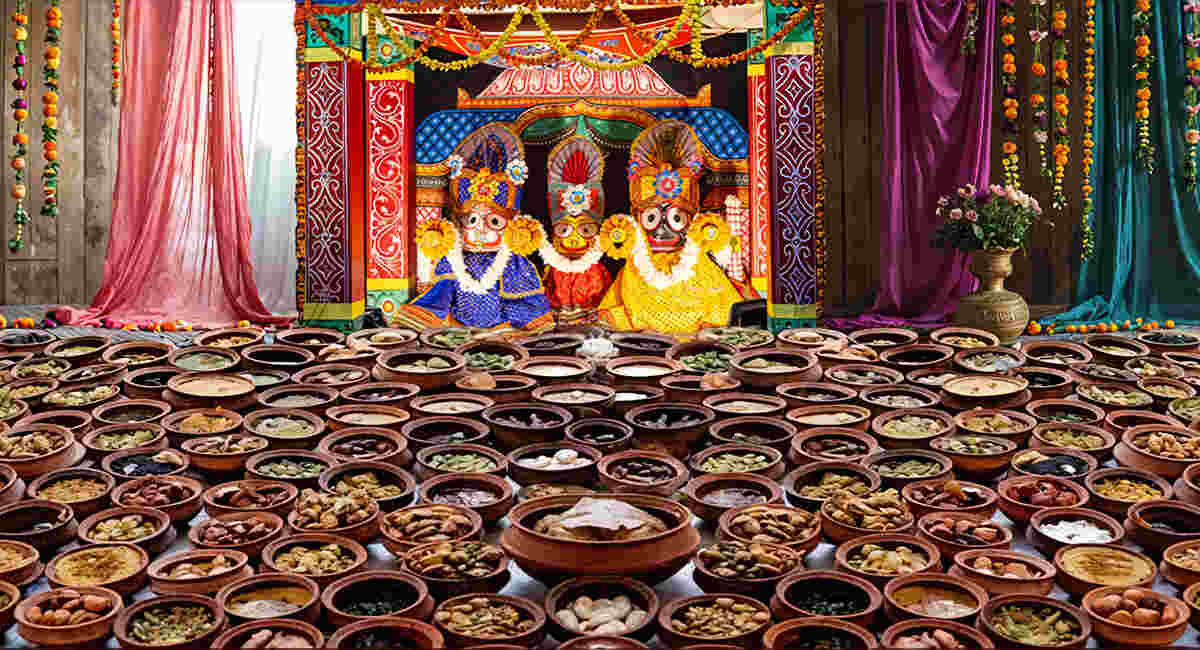Chappan Bhog: Offerings to Lord Jagannath
India’s spiritual heritage is deeply entangled with food offerings made to deities. Lord Jagannath, the ruling deity of the Jagannath Temple in Puri, Odisha, is presented with a magnificent array of 56 dishes called the Chappan Bhog, which is the most lavish and highly adored. This celestial feast, provided daily and during grand festivals, is more than just a meal—it embodies devotion, culture, and sacred tradition.
The Origin of Chappan Bhog
Chappan Bhog translates to 56 food items in Hindi (chappan meaning 56, bhog meaning offering or feast). According to legend, Lord Krishna, an incarnation of Lord Vishnu and closely associated with Lord Jagannath, used to eat eight meals daily. However, during the episode of Govardhan Leela, when he lifted the Govardhan Hill to protect the villagers of Vrindavan from torrential rain, he didn’t eat for seven days. To make up for the missed 56 meals (8 meals × 7 days), the devotees prepared and offered 56 different dishes to the Lord once the storm ended. This offering became known as Chappan Bhog.
Over centuries, this act of devotion transformed into a sacred ritual and was incorporated into the worship of Lord Jagannath, believed to be a manifestation of Lord Krishna.
The Ritual of Offering at the Jagannath Temple
The Jagannath Temple in Puri is one of the Char Dham pilgrimage sites and holds immense significance in Vaishnavism. Here, the Chappan Bhog is part of the Mahaprasad—the sacred food offered to Lord Jagannath and his siblings, Lord Balabhadra and Devi Subhadra.
The temple kitchen, one of the largest in the world, prepares six main meals each day for the deities. The cuisine is prepared using traditional methods in earthen pots over clay ovens heated by wood without commercial spices, onions, or garlic. After offering the food to the deities, the priests declare it Mahaprasad and then distribute it to devotees on the temple premises.
The Chappan Bhog is typically offered during significant festivals, particularly Anavasara (15 days when the deities are not visible to the public) and Ratha Yatra, the annual chariot festival. However, priests or temple cooks regularly offer miniature versions of the Chappan Bhog.
What’s Included in Chappan Bhog?
The 56 items in the Chappan Bhog are a balanced mix of sweet, savory, fried, steamed, baked, and liquid preparations, crafted to appeal to all senses and maintain sattvic (pure) food principles. While the exact list varies slightly between temples and regions, the traditional Puri version includes items such as:
Staple Foods & Rice Dishes:
- Ghee rice
- Khichdi (rice and lentil preparation)
- Pakhala (fermented rice water)
- Kanika (sweetened rice)
- Lemon rice
- Tamarind rice
- Coconut rice
- Plain steamed rice
Lentils & Pulses:
- Dalma (lentils with vegetables)
- Muga dal (yellow moong dal)
- Chana dal (Bengal gram dal)
- Urad dal
Vegetable Preparations:
- Saga bhaja (fried leafy greens)
- Khatta (sweet and sour preparations like tomato khatta or mango khatta)
- Besara (vegetables in mustard paste)
- Baigana bharta (roasted eggplant mash)
- Alu dum (potato curry)
- Mixed vegetable curry
Fried Snacks:
- Bara (lentil fritters)
- Alu chop (potato patties)
- Mathapuli (deep-fried stuffed fritters)
- Kachauri (stuffed puri)
- Puri
- Papad
Sweet Dishes:
- Khaja (flaky fried pastry soaked in sugar syrup)
- Malpua (sweet pancake)
- Rasabali (milk-soaked sweet)
- Chhena poda (roasted cheese dessert)
- Rasa gulla
- Chhena gaja
- Ladoo
- Suji halwa
- Mitha dahi (sweet curd)
- Kheer (rice pudding)
- Payas (sweetened milk)
- Manda pitha
- Kakara pitha
- Arisa pitha
- Jhilli
Other Unique Offerings:
- Sukhila khaja (dry sweet puff)
- Bhoga mandap khichdi
- Gaja
- Dal puri
- Sukhua bhaja (dry-fried fish-like snack made with vegetables)
- Chhena ladoo
- Pana (fruit or herbal drinks)
- Makar chaula (sweetened rice with banana and coconut)
- Saga bhaja (fried greens)
- Thali pitha
- Moong dal chakuli
- Khatta ambila
- Sitabhog
- Magaja ladoo
- Chakuli pitha
- Kancha kadali bhaja (fried banana)
- Mahura (temple-style mixed vegetable curry)
The offerings are arranged meticulously and presented with immense care. The variety ensures nutritional balance while celebrating regional and traditional flavors.
Symbolism Behind Chappan Bhog
Chappan Bhog is not merely a feast—it’s a spiritual act of love, devotion, and gratitude. Every ingredient, every dish is prepared in sanctity and reverence. The process reflects:
- Bhakti (devotion): Each dish is lovingly made as an act of service to the Lord.
- Diversity and abundance: They represent the Lord’s grace and the richness of life.
- Unity in variety: The offering unites various tastes, symbolizing how all paths can lead to the divine.
Chappan Bhog Beyond Puri
Though Puri is the epicenter of this sacred tradition, many ISKCON temples and other Jagannath temples across India and the world also recreate Chappan Bhog, especially during festivals like Janmashtami, Ratha Yatra, or Govardhan Puja.
In Mathura and Vrindavan, devotees prepare the Bhog to honor Lord Krishna. Even in homes, many families take up the devotional task of organizing all 56 dishes as part of personal sadhana.
Final Thoughts
Chappan Bhog is more than just food—it is a divine experience, a celebration of devotion, and a spiritual tradition that binds millions of followers to Lord Jagannath. With its rich flavors and symbolic depth, it continues to inspire awe, faith, and unity across generations. Whether you’re a devotee, a foodie, or a cultural explorer, the story and spread of Chappan Bhog will surely captivate your senses and stir your soul.


